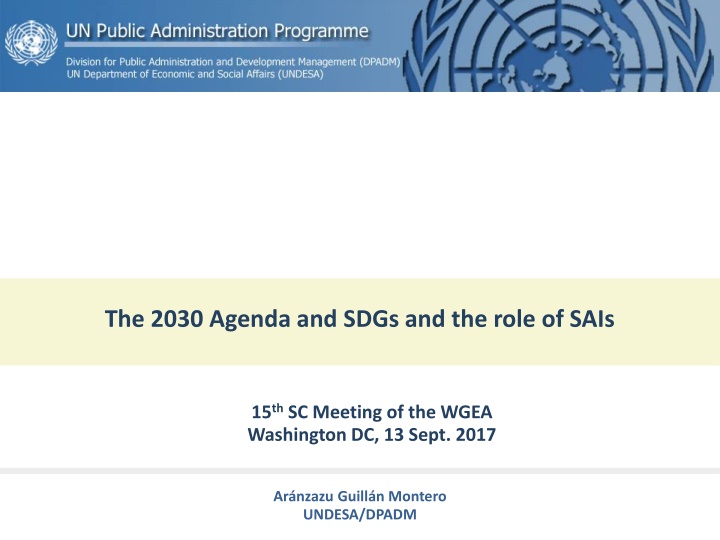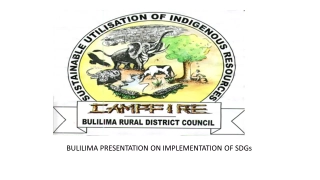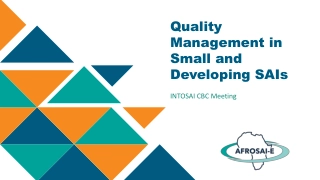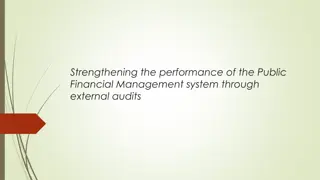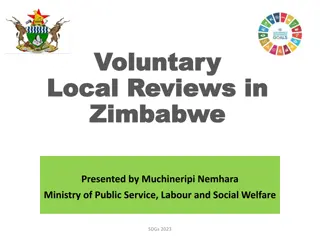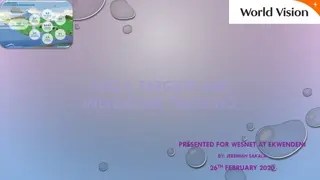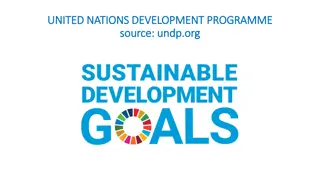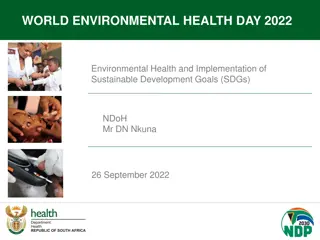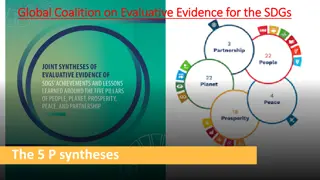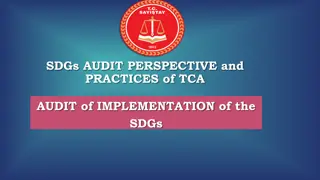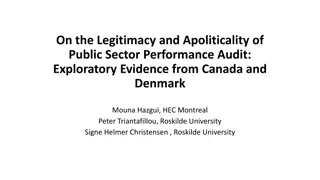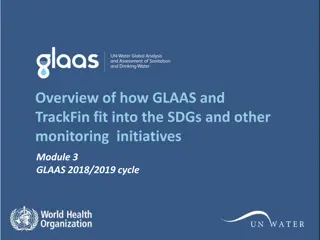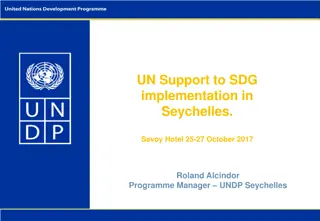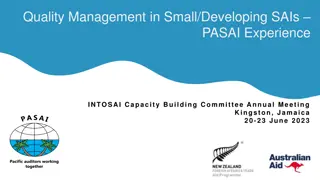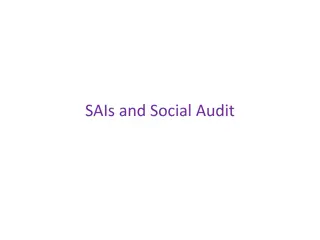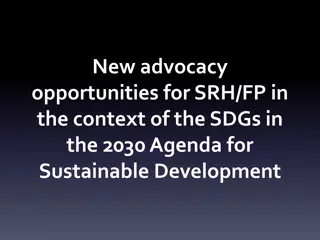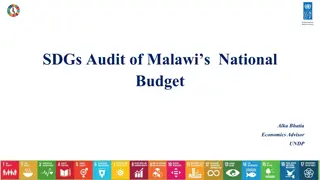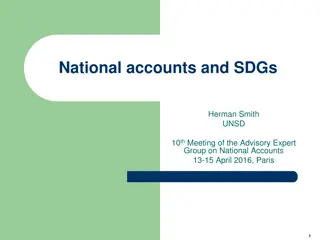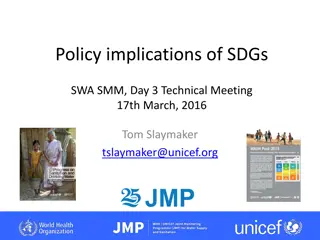Role of SAIs in Implementing the 2030 Agenda and SDGs
The 2030 Agenda, adopted in 2015, outlines a global action plan for sustainable development. This agenda requires the participation of various stakeholders and the integration of SDGs into national planning processes for effective implementation. Monitoring, resource mobilization, and engagement of multiple stakeholders are key aspects of achieving the SDGs by 2030.
Download Presentation

Please find below an Image/Link to download the presentation.
The content on the website is provided AS IS for your information and personal use only. It may not be sold, licensed, or shared on other websites without obtaining consent from the author.If you encounter any issues during the download, it is possible that the publisher has removed the file from their server.
You are allowed to download the files provided on this website for personal or commercial use, subject to the condition that they are used lawfully. All files are the property of their respective owners.
The content on the website is provided AS IS for your information and personal use only. It may not be sold, licensed, or shared on other websites without obtaining consent from the author.
E N D
Presentation Transcript
The 2030 Agenda and SDGs and the role of SAIs 15th SC Meeting of the WGEA Washington DC, 13 Sept. 2017 Ar nzazu Guill n Montero UNDESA/DPADM
The 2030 Agenda is underway Adoption of the 2030 Agenda on September 25th 2015 as a result of a participatory process. Related frameworks: Sendai Framework for Disaster Reduction (June 15) Addis Ababa Action Agenda (July 15), which commits to strengthen national control mechanisms, such as SAIs . Paris Climate Agreement (Dec. 15). SDG Global Indicator Framework endorsed by UN SC in March 2016, by ECOSOC on 7 June 2017 and approved by General Assembly on 6 July 2017 indicators to be reviewed and refined annually and comprehensively in 2020 and 2025 . Global Follow-Up and Review architecture defined by UNGA/Guidelines for voluntary review. HLPF of SDGs era: 22 countries presented their VNRs in 2016; 43 countries in 2017; and 44 have already volunteered for 2018.
Integrated: a network of targets Source: D. Le Blanc. Towards integration at last? The sustainable developent goals as a network of targets
Implementing the 2030 Agenda Building awareness and dissemination Relate 2030 Agenda to country demands and priorities Ensure legitimacy, include different perspectives and create partnerships for implementation Engaging multiple stakeholders Tailoring SDGs to national, subnational and local contexts and setting priorities Integrate SDGs in planning and policy processes (not a separate agenda) Creating horizontal and vertical policy coherence (sectors and levels of government) Develop integrated policy solutions that involve different sectors and levels of government and public administration Identifying and mobilizing resources Ensure resources (different sources) and necessary capacities for implementation (technology, data, etc.) Monitoring, review and reporting Measure progress towards the achievement of SDGs and ensure accountability for performance and results Source: UNDG (2017) Mainstreaming the 2030 Agenda for Sustainable Development
Countries moving ahead with implementation Progress is evident, but its rate in some areas is slower than needed to meet the targets by 2030 (SDG Report 2017): Reducing poverty, hunger and malnutrition, and addressing inequality, as overarching challenges with negative trends in some regions The negative impact of environmental stressors (e.g., on health, natural disasters), particularly on women, expected to grow unless action is taken Lack of official statistics, data and effective monitoring systems as important challenges HLPF / VNR show extensive national preparations and strong commitment of national governments: Internalizing SDGs into development strategies and planning processes (e.g., Uganda, Indonesia) Setting coordination mechanisms Enhancing the alignment of budgets and policy making Strengthening evidence and science-based policy making
Countries moving ahead with implementation Leveraging inter-linkages between SDG targets requires leadership and improved policy coherence and coordination through WoG approaches (e.g., Finland) institutional arrangements for SDG implementation: Countries are creating new entities (e.g., Colombia), leveraging existing institutional frameworks for SD (e.g., Germany), relying on the leadership of key ministries (e.g., Norway). Need to translate interlinkages into policy-making, budgeting and institutional structures. Aligning budgets (e.g., Mexico, Norway) Tools: mapping of inter-linkages, institutions and programmes, and stakeholders (e.g., Sri Lanka). Need to create incentives for enhancing the engagement of sub- national and local authorities. Gaps remain in engaging Parliaments, which are however proactively mobilizing around SDGs in several countries through oversight functions (e.g., Finland), specialized committees (e.g., Fiji), special advisory groups (e.g., Germany).
Countries moving ahead with implementation Multi-stakeholder engagement is increasing and changing in nature: Importance of bringing all stakeholders (including new actors) though joint multi-stakeholder whole of society approaches (e.g., Finland). Participation takes place through institutionalized mechanisms VNRs, SDG implementation entities, etc. (e.g., Brazil). Need of strengthening coordination and communication with non- government stakeholders. Monitoring frameworks: Need to integrate M&E structures into single national systems to reduce overlaps and parallel structures. Localizing targets and indicators is critical. Countries are exploring different M&E institutional arrangements such as new inter-agency structures (e.g., Georgia) or specialised units (e.g., Moldova). Most countries rely on National Statistical Offices (NSO) for SDG monitoring but they need enhanced capacities and coordination with other actors. Importance of addressing capacity gaps and investing in data collection, disaggregation and analysis.
SAIs commitment to support 2030 Agenda 1 2 3 4 Auditing preparedness and national systems of follow-up Performance audits on programmes that contribute to SDGs Being model of transparency and accountability Assessing and supporting SDG 16 INTOSAI Strategic Plan 2017-22: Contributing to the follow-up and review of the SDGs within the context of each nation s specific sustainable development efforts and SAIs individual mandates XXII INCOSAI Abu Dhabi Declaration: Commitment to making a meaningful independent audit contribution to the 2030 Agenda Guidance and support for SAIs in their contribution to SDGs Frameworks for production of high-quality information under 4 approaches to share with internal and external audiences Opportunities for capacity enhancement and knowledge sharing- IDI
SAIs are making significant progress Some SAIs have included SDGs into their strategic plan (e.g., Bhutan) or are considering to do it (e.g., Sierra Leone) SAIs are conducting audits of how governments have prepared for SDG implementation (e.g., Austria, Brazil, Canada, ARABOSAI) SAIs are contributing to follow-up and review (e.g., Brazil s TCU was part of the official delegation to the HLPF and contributed to the VNR) SAIs are conducting audits in SDG areas (e.g., Jamaica on energy, UAE on health indicators) SAI Sudan is working with Parliament to enhance auditors capacity to audit SDGs At regional level, 11 SAIs in OLACEFS are conducting a cooperative audit of Target 2.4 on food security IDI-KSC programme on Auditing SDGs is underway: Guidance on auditing preparedness for SDG implementation eLearning course for 44 English-speaking SAIs underway; 14 SAIs in OLACEFS starting in Sept. with focus on SDG5; CREFIAF and ARABOSAI in early 2018 Audits to be conducted in 2018 Compendium of good practices
Multiple opportunities Recognition of the role of SAIs (UN resolutions, AAAA) and INTOSAI strategic direction. SAIs are part of the SDG implementation and follow-up and review ecosystemat the national level - Proactively reach out to government and stakeholders to inquire about SDG implementation and to advocate SAI role. Clear value of SDG audits (e.g., auditing MoI and use of resources; auditing preparedness to provide baselines for reviewing implementation). Adoption of WoG approach by governments provides opportunities for new audit methodologies and approaches to assess governance complexity. SAIs have accumulated experience auditing SDGs w/o knowing it . Contribution to SDG follow-up and review at different levels: National: Each country decides how to review and report on progress. Government can decide to engage the SAI. SAIs could advocate role and engage with stakeholders to contribute to national reviews. Regional: Collaboration with UN Regional Commissions and regional mechanisms. Global: SAIs could contribute to the VNRs in different forms. Through INTOSAI, provide inputs to the HLPF on progress towards the SDGs from the SAI perspective.
Follow-up and review at global level -HLPF National National voluntary voluntary presentations: presentations: with or without with or without national national indicators indicators SDG Progress Report (annual) Global Sustainable Development Report (GSDR) (4 years) High High- -level Political Forum level Political Forum (HLPF) (HLPF) Financing for Development Forum: Additional indicators on FFD Thematic/Goal Thematic/Goal reviews reviews: based on thematic indicators National SDG reports: National SDG reports: Based on national Based on national indicators indicators Regional reviews: Regional reviews: Based on regional Based on regional and/or global and/or global indicators indicators
But also some challenges Low awareness of SDGs in government, SAIs and society. SAIs have different mandates (e.g., performance audit) reflect on different roles, responsibilities and contributions. Distinctiveness of auditing SDGs new approaches require enhanced capacities and resources: Examine complexity and interconnections - SDG audits have to look at the interconnections between goals and targets. This requires a focus on outcomes and examining interconnected and boundary spanning issues instead of looking at individual programmes, projects and agencies as silos. Wide stakeholder engagement in the audit process - SAIs have to look beyond traditional mechanisms of collecting evidence and consult with a wider set of stakeholders throughout the audit process, while preventing bias and preserving independence. Focus on inclusiveness - expand traditional effectiveness questions to ask about issues of inclusiveness and how these have been met. Audit performance information - When auditing SDG implementation, SAIs need to look at performance information and develop capacity and approaches for auditing performance information and performance measurement systems. Availability, quality and credibility of disaggregated data and how to leverage data tools.
Final reflections Importance of taking a strategic approach to engaging with SDGs (value of SDG audits, outputs, capacities needed). Extensive scope of the 2030 Agenda requires prioritizing SDG audits: Not all SDGs at once: preparedness; government plans and objectives; risks that government objectives not achieved; VNR process; sets of SDGs (based on context and SAI priorities) Embedding a sustainable development perspective into environmental auditing: Integrated approach and SDG inter-linkages selection (e.g., programs with integrated approach; sets of interlinked SDGs), conducting (e.g., social and economic dimensions) Showing and effectively communicating results: Aggregation of findings to provide inputs into follow-up and review processes Who? How? To whom? - Communicate to different audiences to show relevance, trigger remedial action and enhance trust and credibility Importance of partnerships and collaboration Enhancing SAI capacity by leveraging knowledge-sharing and cooperative approaches.
